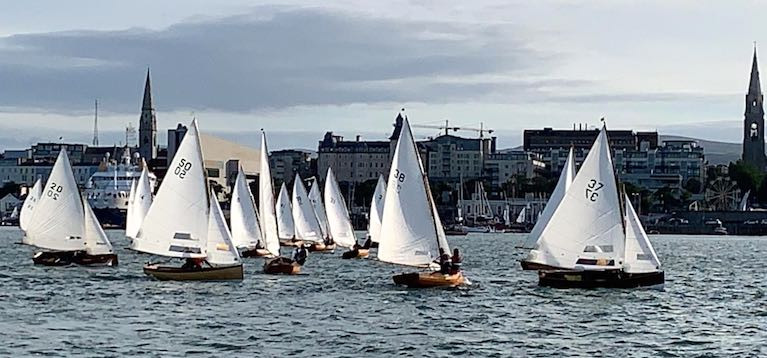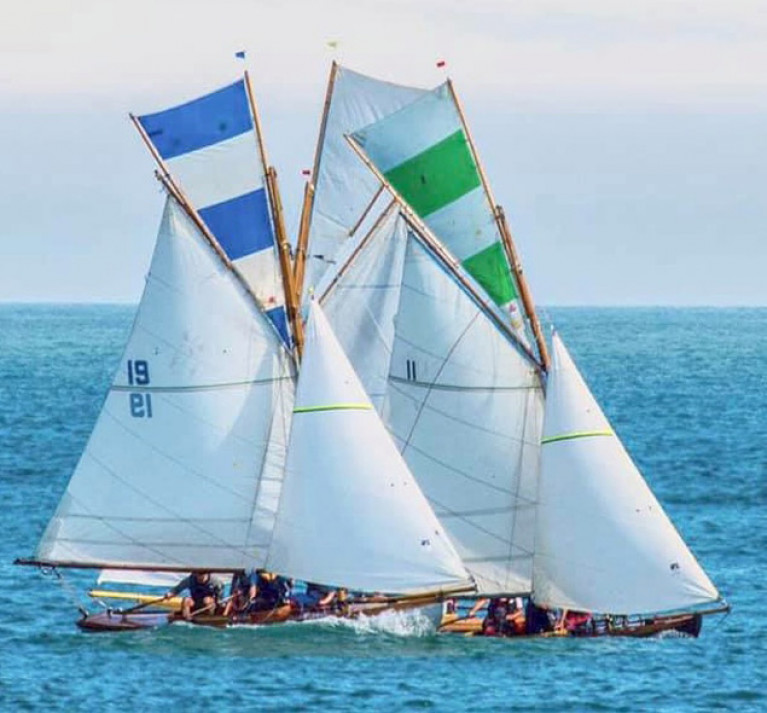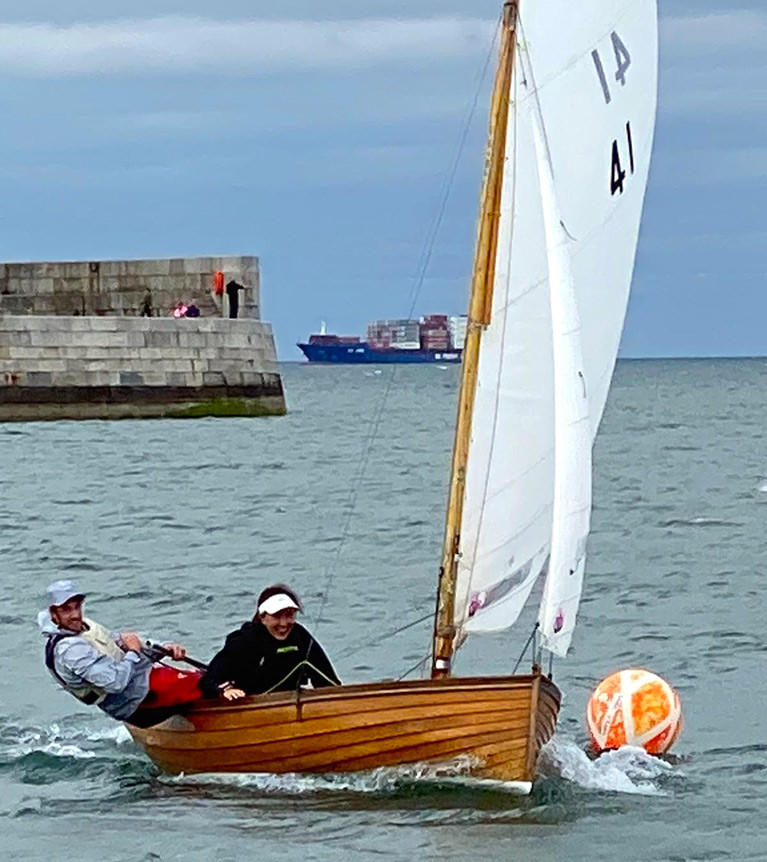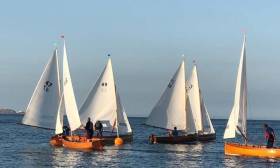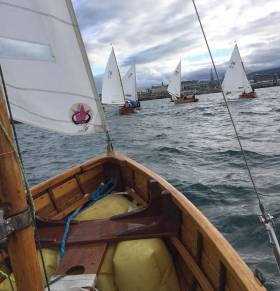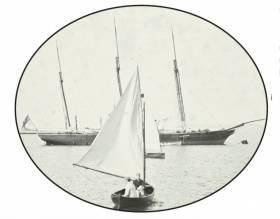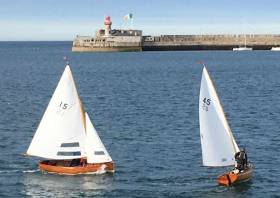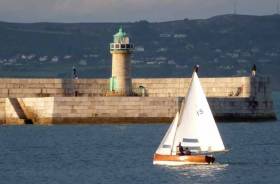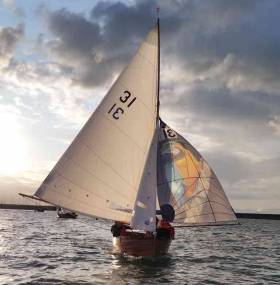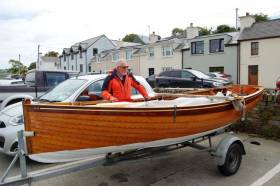Displaying items by tag: Water Wag
All the Good Guys Win in the Dun Laoghaire Harbour Water Wags
When the Dublin Bay Water Wags started racing 133 years ago in 1887, every boat had a Spinnaker Guy, and a vital role he played too in dealing with the eternal contest with Tidal Eddy. So far, however, there’s no word that a Lazy Jack or a Bob Stay has been seen racing aboard any of these historic boats. But it seems that the Guys are now to be found everywhere, even on the helm, and of course they’re all Good Guys to a man - or indeed a woman, should it be Mrs Guy.
This all came to a weird sort of peak yesterday (Wednesday) evening, when perfect sunlit racing conditions rounded out a classic ridge day, providing sailing prospects so encouraging that, despite the dampening effects of social distancing and whatever, the class had its best turnout of 2020 thus far, 25 boats being on the line for two races sent off by the ubiquitous Con and Cathy Murphy.
The “weird peak” emerged from the fact that the first race was won by Guy O’Leary, while the second – after a slight kerfuffle towards the finish line with that Howth guy Ian Malcolm racing the 1915-vintage Barbara – was won by Guy Kilroy. Other guys and gals figured in the top results, but for the moment it’s enough to be contemplating this Guyfest at the front of the fleet, when you remember it was in a fleet already deploying 25 Spinnaker Guys.
 Classic summer evening in Dun Laoghaire as 27 guys are busy downwind in the Water Wags. Photo: Con Murphy
Classic summer evening in Dun Laoghaire as 27 guys are busy downwind in the Water Wags. Photo: Con Murphy
Facemasks With Club Logos An Idea as Big Events Fall While Smaller Ones Quietly Take Place
A while back, the off-the-wall idea was mooted of creating a line of quality face-masks, tastefully printed or even embroidered with sailing and yacht club logos. The world of high fashion was already on to the idea of designer-labelled COVID-contesting kit, and in our more sedately-minded sport, some of us were thinking it might soon become a good idea to have logo-featuring facial covering if the pesky disease thing didn’t go away, thereby requiring us to make mask-wearing as nearly trendy as possible, with - in some cases - the useful juice of a touch of snobbery to give it spice.
Certainly, it will take something extra to get sailing folk to use the things. For us, they generally come with distinctly unpleasant associations, because for anyone who runs a boat with a touch of DIY effort, facemasks are part of the scenario, and they are inextricably linked with the most horrible jobs of all, such as getting the anti-fouling racing-smooth in under the aft end. And though you should of course also be wearing goggles, many don’t, while those of us wearing spectacles find our misery with specs is exacerbated with a mask by seeing everything through thickening mist.
 The Royal Cork YC’s very elegant burgee. In these extremely challenging times, would people be more prepared to wear a proper face mask if it incorporated their club’s logo?
The Royal Cork YC’s very elegant burgee. In these extremely challenging times, would people be more prepared to wear a proper face mask if it incorporated their club’s logo?
Of course, I’m not suggesting you should immediately use your crisp new club logo-embellished quality facemask for those nasty jobs. But that said, after this coronavirus has been stalking us for a year or two, a certain cachet will attach to arriving down to join your work team of crewmates under the mighty ship, and attacking the preparation work on the nether parts of the vessel attired with an obviously very well-worn washable Royal Cork Yacht Club face mask to protect your schoolgirl complexion, and keep those nauseous fumes and poisonous particles out of the vital tubes.
It reminds me of when I first met up with American sailors wearing the always-trendy Sperry Top-Sider deck shoes. This wasn’t until the 1960s, yet the Top-Siders had been around since 1935, when Paul Sperry had become mighty inventive with non-slip soles after slithering over the side of his boat one night in Long Island Sound while wearing the usual glorified tennis shoes which passed for deck shoes in those days.
His eventual creations, with the uppers based on moccasin design, were soon fashionable, and even in the late 1960s, they still looked so good by comparison with anything in Europe that they were the height of style, and never more stylish than when looking well worn, as though they’d notched a Bermuda Race and then a Fastnet Race as well.
 “No gentlemen would ever wear shiny new Top-Siders.” An advertisement honouring product longevity from an era when people wore yachting caps on every possible occasion, and planned obsolescence was only a gleam in some asset strippers eye
“No gentlemen would ever wear shiny new Top-Siders.” An advertisement honouring product longevity from an era when people wore yachting caps on every possible occasion, and planned obsolescence was only a gleam in some asset strippers eye
In fact, while I sometimes saw an American wearing an immaculately-polished pair of Top-Siders, there was never any doubt that this was well-loved footwear of considerable vintage, and it was virtually unknown to see anything remotely like a new pair of Top-Siders. Apparently the secret behind this was that, when you finally did have to buy a new pair, you’d get your gardener to wear them for a busy fortnight or even a month before you’d dream of using them yourself……
Royal Ocean Racing Club
We can’t of course get some obliging employee to wear our club-logo facemask to give it honourable venerability, but how the idea of such facemasks turn out will become part of the quaint world of club regalia folklore. Club cravats and bow ties are really a bit too much for most of us, but once upon a time, when people still wore ties, the seahorse-logo neck-tie of Royal Ocean Racing Club (where our own Laura Dillon is currently Rear Commodore) was quite the thing to be qualified to wear, and one evening in that wonderful RORC clubhouse in the heart of London, a fresh-faced young offshore-racing enthusiast burst into the bar and brightly announced to Douglas Campbell, the 100% proof Scottish barman, that he’d just become a member, and would like to buy a tie.
 An architectural gem and a nautical powerhouse in the heart of London – the RORC Clubhouse, once ruled by the legendary Douglas Campbell
An architectural gem and a nautical powerhouse in the heart of London – the RORC Clubhouse, once ruled by the legendary Douglas Campbell
 Laura Dillon, RORC Rear Commodore, is still the only woman sailor to have won the All-Ireland Helm Championship
Laura Dillon, RORC Rear Commodore, is still the only woman sailor to have won the All-Ireland Helm Championship
Douglas had a Scots accent so deep and growly you could have run the lighting off it, so he just looked up from under his heavy eyebrows and gruffly demanded: “Silk or Terylene?”
Younger readers, ie anyone under the age of about 60, will need to know that Terylene was the fancy new world-beating synthetic fibre which eventually became known, American-style, as Dacron. Our new young member back in the day in the RORC knew exactly what it meant, but he needed to be apprised of the full significance of the choice, so he responded: “I just don’t know Douglas, which do you recommend?”
Douglas ground out the reply, with his deep slow voice made even slower and deeper and growlier by this over-keen assumption of first-name familiarity:
“Well, if you just want to hold the trousers up, the silk will do. But if you need to start the outboard, then it has to be the Terylene”.
That was then, nowadays people need to be told that many offshore racers’ tenders carried quaint Seagull outboards which you started by winding a removable pull-rope round a wheel on top, and in extemis in the absence or breakage of that pull-rope, you were well stuck if somebody’s tie wasn’t up to the job – it was no laughing matter.
And nor is COVID-19, but heaven knows we need something to brighten our days as the full effects of this pandemic threaten to embrace us again in Lockdown claustrophobia, and we find that our news of sailing sport is increasingly reliant on local events which would probably be much happier to be left on their own to get on with their usually fairly private sailing.
 Family affair. Peter Courtney racing Oonagh – his family first became involved in the Howth 17 class in 1907
Family affair. Peter Courtney racing Oonagh – his family first became involved in the Howth 17 class in 1907
As the dates of what would have been major national and international fixtures come and go with events un-sailed in this pandemic-constrained season, we find we’re cherishing the more manageable second-tier fixtures with a strong home-club bias which can still be staged with the proper controls in place. These are events which will probably have a slightly quirky character combined with a distinct local flavour which will provide an inbuilt level of crowd-control in these strange times.
For they are indeed strange times when, for long enough, it had seemed that “Three’s a crowd” was the mantra of the day, with social-distancing providing the code. And even now when the basics seem to be that we’re allowed close groups of ten if we watch our manners, we must always remember the ultimate fallback ruling is: “If in doubt, stay at home”.
In those circumstances, how do you transfer the safety of home and its instinctively-known rules and restraints into the fluid sociable structures of the group behaviour which used to be the natural basis of sailing’s shoreside post-race gatherings?
Dublin Bay & Cork Harbour cruiser fleets
“With some difficulty, and in a mood of constant vigilance” seems to be the answer, as we see modern classes such as the Dublin Bay and Cork Harbour cruiser fleets develop a controlled form of their normally hyper-sociable programmes, while in classic labour-intensive classes such as the Dun Laoghaire Water Wags and the Howth 17s, it seems to be a matter of baby steps - for want of a more robust phrase – as acceptable crew bubbles are evolved to make racing possible.
 “Let there be light”. Club cruiser racing returns to Cork Harbour and the RCYC at Crosshaven on Thursday, July 9th 2020. Photo: Robert Bateman
“Let there be light”. Club cruiser racing returns to Cork Harbour and the RCYC at Crosshaven on Thursday, July 9th 2020. Photo: Robert Bateman
But with every race in a shortened season thus becoming more precious in an already limited programme, people will not lightly relinquish their carefully-assembled crew bubbles for initially attractive short-handed events. Thus when it was announced some time ago that Howth’s annual Aqua Restaurant Two-Hander Race’s format – formerly aimed at the cruisers – was going to be extended to all Howth classes when raced today (Saturday, July 18th), it seemed a reasonable enough idea at the time, when personnel limitations looked like being a central theme of the 2020 season.
Howth Seventeens
However, since then the ancient Howth Seventeens have been carefully building up their fleet afloat together with the maximum crew groupings qualified to race the boats, so now their attitude to the Two-Hander invitation is: “Thanks, but no thanks”.
In a normal season, the 1898-established Howth class would sail an impressive total of between 55 and 60 races. But in this shortened season, even with some add-ons if the Autumn proves clement there’ll be far fewer races, and each one will be that much more precious as a result.
The time-honoured Saturday Howth 17 contests - each one a mini-regatta with the fleet resplendent in their jackyard topsails – have become such a pillar of the class’s programme that the idea of one of them being a race in which personnel numbers are reduced to just two per boat is something which smacks of sacrilege when they’ve found that a Howth 17 will often give of her best with four on board.
 Classics addict. Ian Malcolm won the Howth 17s last Tuesday, and then took fourth in the Water Wags in Dun Laoghaire on Wednesday.
Classics addict. Ian Malcolm won the Howth 17s last Tuesday, and then took fourth in the Water Wags in Dun Laoghaire on Wednesday.
In an age when modernity is such a dominant feature of popular thinking, building up such a large group of enthusiasts with their shared joy in racing boats of an ancient type is a remarkable community achievement, but it doesn’t just happen by accident. Slightly interested newcomers are gently but persuasively drawn into the net until they become totally committed class enthusiasts.
And though the boats are based on a revered One-Design concept, an assiduously maintained double-scoring system of both scratch and handicap divisions is a class-strengthening recognition of the differences in human abilities and aptitudes, as it ensures that nearly every boat genuinely wins a prize.
In some ways, this was the biggest difference I noticed when I moved from the north to the south of Ireland very many years ago. Up north, One-Design means One-Design, and the idea of having a handicap division within a One-Design class probably offended against the tenets of the majority religion.
Water Wags
But in Dublin Bay and Howth, handicapping in One-Designs was regarded as being every bit as normal as having handicaps in club golf, and it was something which contributed greatly to the extraordinary longevity and good health of many of the OD classes.
The strong historical basis of all this became evident recently when the Water Wags Honorary Treasurer David Clarke was putting some old paperwork in order, and he discovered that the yellowing documents included a copy of the Evening Herald for Friday 3rd September 1939.
At first glance, you might think the Dublin daily evening paper had been kept because its front page featured disturbing news from Eastern Europe regarding an increasing unpleasantness between Germany and Poland. Indeed, maybe that had something to do with it. But the real reason it is in there is because it includes the DBSC Handicaps for the next day’s racing, on Saturday, September 4th 1939.
 The Water Wag Class’s copy of Dublin’s Evening Herald for Friday 3rd September 1939. You might well think the interest is in various unpleasant events in Eastern Europe……Courtesy David Clarke
The Water Wag Class’s copy of Dublin’s Evening Herald for Friday 3rd September 1939. You might well think the interest is in various unpleasant events in Eastern Europe……Courtesy David Clarke
 …..but in fact the focus was on the handicaps as they applied to the Water Wags on Saturday, September 4th. Courtesy David Clarke
…..but in fact the focus was on the handicaps as they applied to the Water Wags on Saturday, September 4th. Courtesy David Clarke
And they don’t half bend over backwards to keep everyone in each class involved. Few more so than the Water Wags. They may not match the mixed cruisers, where one boat – the deliciously misnamed Windward – is allowed 41 minutes. But then the Water Wags were allegedly One-Design, yet northern OD sailors would have been appalled to discover that they were so tolerant that one boat – Glanora – was generously allowed all of 15 minutes by the two hotshots, Coquette and Penelope.
 The 26ft gaff cutter Marie (seen here in 1966) was one of the boats featured in the 1939 DBSC handicaps list – she was allowed 39 minutes against the scratch boat, Harald Osterberg’s 14-ton Bermudan cutter Marama. Built by J E Doyle of Dun Laoghaire in 1893 and designed by his daughter Maimie (who also designed the new type of Water Wag in 1900) Marie is still with us, owned and restored by Roy Ashton of Groomsport in County Down
The 26ft gaff cutter Marie (seen here in 1966) was one of the boats featured in the 1939 DBSC handicaps list – she was allowed 39 minutes against the scratch boat, Harald Osterberg’s 14-ton Bermudan cutter Marama. Built by J E Doyle of Dun Laoghaire in 1893 and designed by his daughter Maimie (who also designed the new type of Water Wag in 1900) Marie is still with us, owned and restored by Roy Ashton of Groomsport in County Down
Olympians Finn Lynch & Annalise Murphy
Quite what handicaps the number cruncher of 1939 would have applied to Olympians Finn Lynch and Annalise Murphy who won the Water Wags on scratch this week is beyond the realms of speculation, but those seriously interested in the well-being of grass roots sailing will have noted that Ian Malcolm with the 1915-vintage Barbara (allowed 4 minutes back in 1939) placed fourth on scratch in the Wags on Wednesday in Dun Laoghaire, while on Tuesday he had taken line honours with his 1898-vintage Howth 17 Aura at Howth, a double classics performance which few if ever can have achieved before, and evidence that, truncated season or not, some people are determined to get in just as much sailing as they can in this truncated season of 2020.
Thus they’re now developing the idea that Howth’s attractive marina/clubhouse complex provides an ideal sailing sport setup in the time of coronavirus, as on the land side it’s a completely closed compound which also provides the club’s only access to moored boats in the outer harbour, a closed compound where entry can easily be restricted to one gateway, and registration and contact tracing can be rapidly developed, particularly with Wave Regatta from 11th to 13th September in mind.
 Howth Yacht Club’s marina/clubhouse complex provides a usefully-closed compound from the landward side.
Howth Yacht Club’s marina/clubhouse complex provides a usefully-closed compound from the landward side.
Round the Kish
As it is, the sailors of Howth have been quietly putting their good fortune to proper use, with the second race of the Fingal Series being staged last Saturday to see Dermot Skehan put in a masterclass demo with his Humphreys-designed Toughnut to do a horizon job on the rest of the fleet of sixteen in a race which took them out round the Kish, and meanwhile, HYC Cruising Group Captain Willie Kearney liaised with the sailing club at Skerries (where so far as I know there’s still no harbour master) in order to ensure that there’d be enough clear quay space for his fleet of 18 Howth cruisers to berth in a social-distance compliant style, and Skerries Sailing Club obliged.
Meanwhile, we note that the Royal Irish YC is right up to speed with the continuing twists and turns of the un-winding and re-winding of the regulations, with a crisp notice issued yesterday informing members that if they want a beer or two after today’s DBSC race, they must still order food with it.
Some day, some day maybe very distant, somebody is going to set a mighty computer to work at calculating just how much weight the thirstier part of our nation has had to put on in order to be comfortably un-parched, and yet COVID-compliant….
Olympians Finn Lynch & Annalise Murphy Win First Race of Dublln Bay Water Wags 2020 season
We think of the venerable Dublin Bay Water Wags as being the quintessential Dun Laoghaire Harbour class. But when the results of their first race of the delayed 2020 season yesterday (Wednesday) evening were analysed, it was noted that the top performers in the turnout of 13 gleaming varnished classic boats included many from outside the leafy confines of South Dublin.
Former Olympian and current classic boat pace-setter Cathy MacAleavey was unable to race owing to having had a hip replaced on Monday (we wish her well), but she made sure her boat, No 42 Molly, was in with a chance through being raced by Olympians Finn Lynch (originally of Blessington SC) and her daughter Annalise Murphy (NYC), Silver Medallist in the 2016 Rio Olympics.
 Sailing is really going again when the Water Wags make their first appearance – William Prentice’s Tortoise (42), Adan Winkelmann (46) and the O’Driscolls from Lough Derg (15) in perfect first race sailing conditions
Sailing is really going again when the Water Wags make their first appearance – William Prentice’s Tortoise (42), Adan Winkelmann (46) and the O’Driscolls from Lough Derg (15) in perfect first race sailing conditions
 The 1915-built Barbara (Ian & Judith Malcolm), crossed the in-harbour line to take fourth
The 1915-built Barbara (Ian & Judith Malcolm), crossed the in-harbour line to take fourth
The hotshots duly obliged by winning, but the top placings thereafter indicated that interest in Water Wag racing is at the very least a Leinster-wide matter, for although Guy KIlroy of Dun Laoghaire was second with Swift, he’s no stranger to the more remote hidden waters of the North Shannon, while third was also Shannon-oriented, as the O’Driscoll family of Lough Derg YC – noted Shannon One Design sailors – have added a Water Wag to their boat portfolio. To make the spread complete, fourth place was snatched by “the Howth boat”, the 1915-built Barbara campaigned by Ian and Judith Malcolm, who are best known for their links to the Howth 17 class and other classics from the board of their local designer Herbert Boyd.
 The classic Water Wag image to launch the 2020 season - Adrian Masterson brings his boat to the mark.
The classic Water Wag image to launch the 2020 season - Adrian Masterson brings his boat to the mark.
After a full lap of the course, racing was very tight for the Water Wags on Monday 26th August for the Single-Handed race as they rounded the leeward mark in Dun Laoghaire Harbour.
Our photo above shows No.3 Pansy (Delany) leads from No. 29 Patricia (Croxon), No.49 Hilda (Byrne), No.47 Peggy (Corcoran), No.46 Mademoiselle (Winkelmann) and No. 42 Tortoise (Prentice). Mollie (Murphy) and Moosmie ((MacFarlane) are out of frame and ahead of this group.
The Water Wag dinghy fleet in Dun Laoghaire competed in the second race of their 132nd season of one design racing on Wednesday 1st May.
Three prizes were on offer, division 1A raced the second of three legs for the Newsom Memorial Cup, Division 1B for the Hilpotsteiner Tankard, and division 2 for the Phyllis Cup. Early in the season, one would not expect a large turnout, due to delays in the preparation and varnishing of the wooden boats.
"twenty-eight boats arrived at the start line"
However, the keenness of the fleet was displayed by twenty-eight boats arriving at the start line. The wind blew from the west at about seven knots. The first start with Tortoise and Pansy leading the fleet was declared a general recall, although the fleet were halfway up the first beat. On the second start under the ‘U’ flag on the long line many achieved good starts.
Adam Winkelmann and Doug Smith in Mademoiselle were unfortunate to have a jib halyard failure while she was in second place and was required to retire.
After three and a half laps of the harbour, over which the shifty wind progressively increased to 15 knots at the finish the order was:
Mariposa Cathy MacAleavey and Con Murphy winner div 1A,
Moosmie, Swift, Tortoise, Gavotte, Mollie, Pansy, Barbara,
Little Tern Tim and Marcus Pearson, winner div 1B,
Peggy, Marie Louise, Skee, Scallywag,
Swallow, David and Anne Clarke winner division 2 ,
Vela, Sara, Phyllis, Good Hope, Freddie, Mary Kate, Eva, Polly, Dipper, Sprite, Nandor, and Chloe.
Mademoiselle and Penelope retired.
Next week will be a handicap pursuit race.
Water Wag Dinghy Talk at National Maritime Museum
Afloat.ie contributor and sailing historian Vincent Delany will describe the development of one design sailing in Kingstown (now Dun Laoghaire) and the significance of the Water Wag on display in the National Maritime Museum in the Dublin Bay town,
The talk, on 8th November 2018 at 8.00 pm includes many previously unseen pictures of yachting in Kingstown (Dun Laoghaire) Harbour.
This is a unique, illustrated, maritime story of 19th century Dublin creativity, entrepreneurship, craft, competition, decline and rediscovery.
The Water Wag season Started in Dun Laoghaire Harbour with a bang on Wednesday last, with a fleet of 22 Water Wags coming to the start line, making it the strongest dinghy class within Dublin Bay Sailing Club. The wind blew from the west force 3-4.
On the first beat most of the fleet headed south towards the old ferry terminal. However the boats which went towards the middle of the harbour did best. At the windward mark, Cathy MacAleavey’s Mollie led from Adam Winklemans Mademoiselle, and Dan O’Connor’s Scallywag. Being a windward leeward course over four laps of the harbour, there were plenty of opportunities for passing.
"Being a windward leeward course over four laps of the harbour, there were plenty of opportunities for passing"
At the end of the breezy race, Mademoiselle won from Mollie and William Prentice’s Tortoise.
For division 1A, Mollie was the winner of the Newsom Memorial Trophy finishing on second place.
For division 1B, Mademoiselle was the winner of the Hilpotsteiner Tankard finishing on first place.
For division 2, Scallywag was the winner of the Phyllis finishing on seventh place.
Next Wednesday, weather permitting, the class expects to have even more Water Wags racing for the handicap race for the Buckingham Cup and the Wigham Trophy.
Nin O’Leary & Alex Thomson Share The Stage with History in Dun Laoghaire
The rapidly-developing partnership between solo offshore veteran Alex Thomson and proven star of fully-crewed boats Nin O’Leary of Cork has been the focus of much attention this week as they visit Cork and Dun Laoghaire.
Thomson’s eye-catching IMOCA 60 Hugo Boss was leader for significant stages in the 2016-2017 Vendee Globe Race, and placed second at the finish in January. During August, his linkup with Crosshaven’s Nin O’Leary and the new Cork-based set–up of Ireland Ocean Racing has had the rumour mills running in overdrive, with much speculation and comment. W M Nixon found that the unique position of Dun Laoghaire provided a special occasion and a relaxed setting in which the prospects for this new and dynamic sailing relationship could be quietly and usefully discussed.
Every so often, the rest of us who sail from other ports are reminded that, in the final analysis, Dun Laoghaire is our sailing capital. Cork Harbour may be very much the national maritime centre, with Galway also making notable research input. But the extensive nature of Cork Harbour is such that it has several places and organisations which could claim to be its main focal point, so the effect is diffused. And while Galway successfully punches way above its weight, the fact that as a city it is only a fraction of the size of Dublin inevitably counts in rating its influence.
Thus Dublin is very much the capital, the place where major decisions are taken in all national areas including the maritime sphere. Dublin Bay is the main area for its sailing, well ahead in the numbers game. And Dun Laoghaire is uniquely the focal point for that sailing, a remarkable and historic artificial harbour through which the pulsing metropolitan energy interacts with the sea and recreational seafaring.
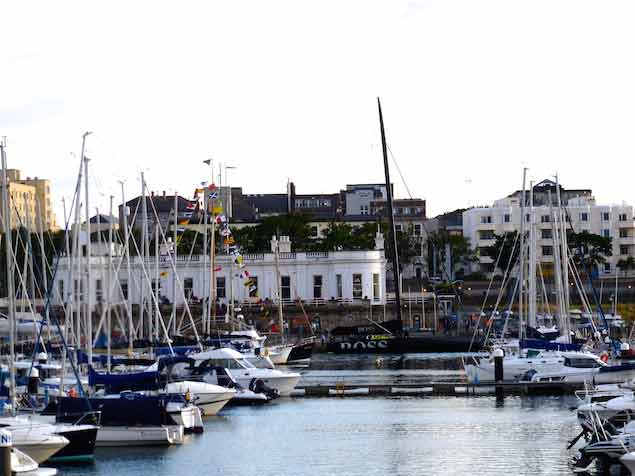 The brooding presence. The all-black IMOCA 60 Hugo Boss berthed at the Royal Irish Yacht Club. Photo: W M Nixon
The brooding presence. The all-black IMOCA 60 Hugo Boss berthed at the Royal Irish Yacht Club. Photo: W M Nixon
Yet at a different level, it is also the home port of many hobby sailors who simply see it as the conveniently-located local harbour which has ample facilities for their own sailing needs. Admittedly the affluence of the area in which it is located has meant that Dun Laoghaire has seen a significant influx of new non-woooden boats over the years, and it has lost some of the historic local One-Design classes which were once the bedrock of its highly-developed sailing scene. But even here, once it became clear that an important heritage was under threat, there has been a growing movement to preserve and expand the most historic class of all.
That has succeeded with the current great good health of the Dublin Bay Water Wag, the world’s first One-Design class, which started life as a simple double-ended little slip of a lug-rigged 13ft sailing dinghy in 1887, but by 1900 was in process of changing itself into a heftier transom-sterned gunter-sloop-rigged clinker-built boat 14ft 3ins long and 5ft 3 ins beam, with a heavy centreplate.
The new design commission was entrusted to boatbuilder J. E. Doyle in what was then Kingstown, but it’s generally reckoned the real designer was his daughter Maimie Doyle, whose talent lay in putting manners on her father’s extremely rough and often nonexistent sketches.
Whatever the design origins, the new boats were soon popular. But with other larger One-Designs available locally, each with its own adherents, it was thought good going if the racing turnout for the new Water Wags climbed above the fifteen mark before the Great War of 1914-1918.
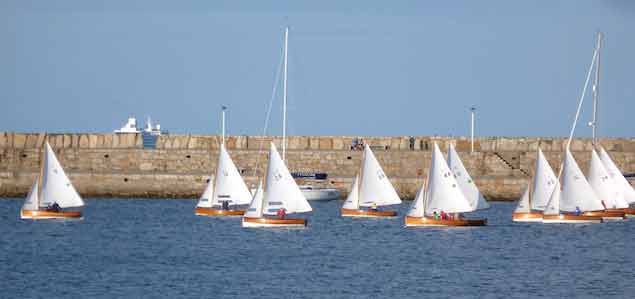 Race on! The Water Wags and Dun Laoghaire Harbour seem made for each other. Photo: W M Nixon
Race on! The Water Wags and Dun Laoghaire Harbour seem made for each other. Photo: W M Nixon
Dublin Bay proved to be ideal for the encouragement of several One-Design classes, but over the years the classic larger wooden boats left the stage to be replaced by more modern plastic boats, with the Dublin Bay 21s exiting in 1986, while in 2004 the Dublin Bay 24s sailed their last race, yet today it could be argued that they’ve been replaced by the growing Dublin Bay J/109 fleet.
A couple of post-World War II timber-built classes are still active in the Glens and the IDRA 14s, but the 17ft Dublin Bay Mermaids of 1932 provenance which originated in Dun Laoghaire are only a token presence, even if they thrive elsewhere. So now the main thrust of Dun Laoghaire enthusiasm for genuine classics sailing has devolved on the Water Wags, which today prosper as never before, and in 2017 with noted maritime historian Hal Sisk as the very active Class Captain, it was hoped they might finally achieve a racing turnout of 30 boats on the starting line.
One hundred and thirty years to become an overnight success? It could only happen in Dun Laoghaire. But as the Water Wags have been such a key part of the sailing fabric of this great harbour for so long, those in the know were well aware that the evening of Wednesday 30th August was the date set for the very special big push, the extra effort towards topping the thirty mark with the racing for the Captain’s Prize, with the fleet including helms and crews with Olympic experience.
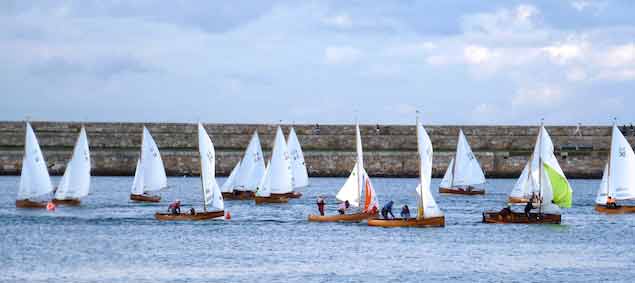 With the class rules’ insistence that spinnakers be set classical style entirely to weather, speed of setting varies enormously. Photo: W M Nixon
With the class rules’ insistence that spinnakers be set classical style entirely to weather, speed of setting varies enormously. Photo: W M Nixon
That racing in turn would be rounded out by a dinner held in the Captain’s own club to end the season’s evening racing. The Water Wags’ home bases are spread along the three older waterfront clubs, so the Captain’s Prize dinner 2017 was already scheduled for Hal’s own club, the Royal Irish, when news emerged that the mighty Hugo Boss, with the new Thomson/O’Leary combo on board, hoped to visit Dun Laoghaire for a couple of days in the last week of August, and could the RIYC accommodate their promotional needs to be seen, be accessible, and provide a base for shore entertainment?
The visit would clash either with the Water Wags special race on Wednesday, or with the regular big-turnout Dublin Bay Sailing Club keelboat racing on Thursday. It fell to the RIYC’s Rear Commodore (House) Jacqueline McStay to decide how to play it, and she played a blinder.
Where others saw a problem, she saw an opportunity. She suggested that the planned dinners for the Water Wags and those involved with Hugo Boss should be turned into one single free-form event, using the RIYC’s historic dining room and spreading into the drawing room next door. She further suggested that as the Water Wags had seniority, Hal Sisk should be the main – indeed, possibly the only - speaker at the actual dinner.
But then, with a touch of genius, she suggested that while the Water Wags were out racing, it would be ever so obliging if Alex, Nin, and their genius boffin-organiser Stewart Hosford could give a little presentation to an audience of members and friends, in the club’s extensive basement room, about themselves, their own plans, and the boat’s movements in the weeks, months and maybe years ahead.
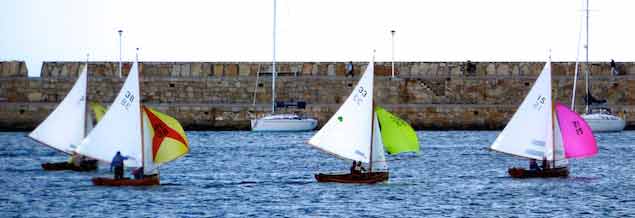 The leaders begin to emerge from the pack, with eventual winner Moosmie leading from Eva (33, Katie Tingle & Dermot O’Flynn), Swift (38, Guy Kilroy, sailed by David Somerville) and Pansy (3, Vincent Delany) Photo: W M Nixon
The leaders begin to emerge from the pack, with eventual winner Moosmie leading from Eva (33, Katie Tingle & Dermot O’Flynn), Swift (38, Guy Kilroy, sailed by David Somerville) and Pansy (3, Vincent Delany) Photo: W M Nixon
It was a masterplan for non-stop nautical entertainment for about six hours, beginning with the sniff around the Hugo Boss (“mighty machine” is an inadequate phrase here) followed by seeing the early stages of the Water Wags’ historic race, then breaking away to take in the presentation by the Talented Three in the basement, followed by the dinner when history and modernity got together, with the enjoyment of this providing a relaxed atmosphere for the exchange of information.
Pessimists would reckon this complex programme for one night in one club had endless opportunities for the wheels to come off, but it went so well you’d swear they did this sort of thing at least five nights a week. As with all Irish events of an outdoor/indoor nature, the Great Imponderable was the weather, and the forecast 24 hours earlier wasn’t at all cheerful. Yet despite that they managed to rouse out a world record of 31 “new” Water Wags, and the photos say everything about perfect conditions for the last evening race of the summer.
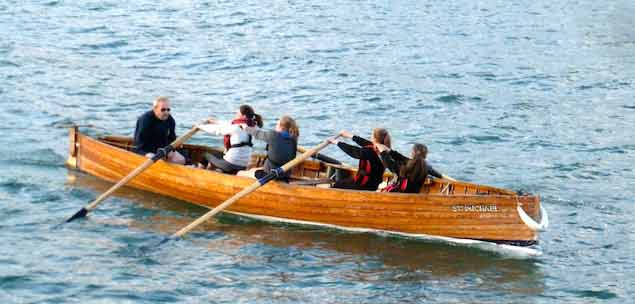 A shared harbour. Trainee crew out for the evening with St Michael’s Rowing Club.Photo: W M Nixon
A shared harbour. Trainee crew out for the evening with St Michael’s Rowing Club.Photo: W M Nixon
It also provided ideal circumstances for a consideration of the current condition of Dun Laoghaire. The place isn’t helped by being in a state of limbo. I’d optimistically hoped that I could get a good shoreside overview of the race by somehow getting myself to the end of St Michael’s Pier at mid-harbour, but it’s still all blocked off as they battle back and forth about the provision or otherwise of a liner berth.
In other words, the shoreside of the harbour is basically inaccessible to the public except down the marina breakwater, but even that limited viewpoint showed that this was a race in a million. And the quality of construction of the main harbour is such that it’s a joy to behold on such an evening, while within it the Water Wags shared the space with skiffs of St Michael’s Rowing Club and boats out from the Irish National Sailing School. Conditions improved as the race went along, with a freshening breeze sharpened up by a long black cloud which moved slowly over towards Howth, leaving crisp evening sunshine behind it, and a markedly veering breeze for the final beat of a four leg windward-leeward course.
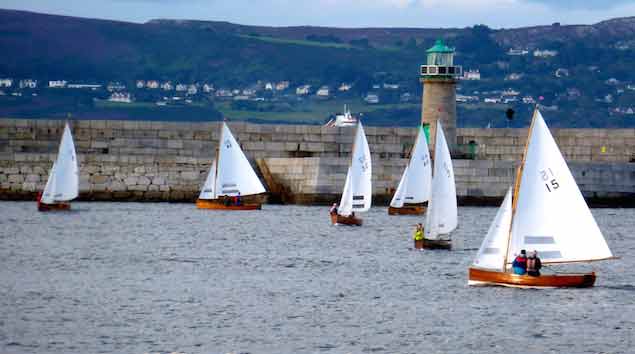 Moosmie (15) seems to have it nicely under control going over to the tricky west side of the harbour…….Photo: W M Nixon
Moosmie (15) seems to have it nicely under control going over to the tricky west side of the harbour…….Photo: W M Nixon
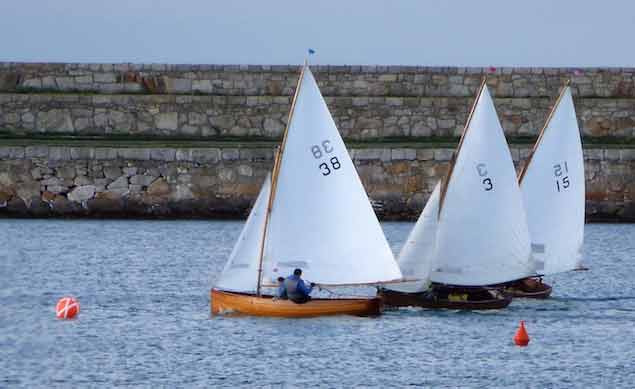 ……but finds herself at the weather mark temporarily behind Swift (38, Guy Kilroy sailed by David Somerville) and Pansy (3, Vincent Delany) Photo: W M Nixon
……but finds herself at the weather mark temporarily behind Swift (38, Guy Kilroy sailed by David Somerville) and Pansy (3, Vincent Delany) Photo: W M Nixon
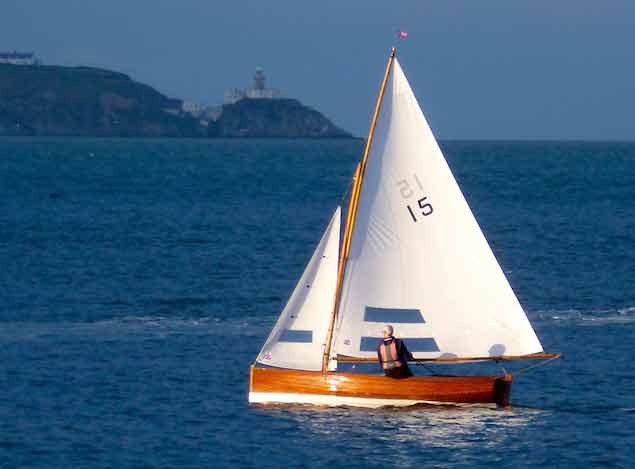 Moosmie clear ahead again. Photo: W M Nixon
Moosmie clear ahead again. Photo: W M Nixon
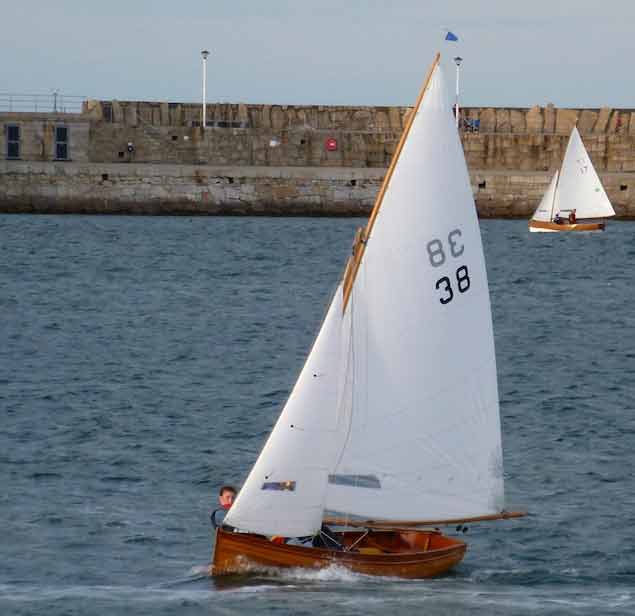 Modern sail-making materials have greatly improved the appearance of the Water Wags. With cotton sails, they often had a starved look, but today’s sailplan looks well fed. This is Guy Kilroy’s 2001-built Swift raced on Wednesday to fifth place by David Somerville. Photo: W M Nixon
Modern sail-making materials have greatly improved the appearance of the Water Wags. With cotton sails, they often had a starved look, but today’s sailplan looks well fed. This is Guy Kilroy’s 2001-built Swift raced on Wednesday to fifth place by David Somerville. Photo: W M Nixon
Thus although David and Sally MacFarlane in the 107-year-old Moosmie (no 15) had overcome a setback or two to retain the lead and sometimes show well clear ahead, the finish came with a bit of a rush of boats in from the right hand side of the beat. While Cathy MacAleavey and Con Murphy were second across in her new Mariposa, finish signal came there none - they’d been OCS. But it was the night of nights for the class’s only Howth owners, Ian & Judith Malcolm with the 102-year-old Barbara. They’d been 21st round the leeward mark, but went onto port and headed straight at that black cloud sitting plumb over their house on the southwestern flanks of the Hill of Howth.
They got themselves a mighty freeing for the tack to starboard, and came roaring in toward the finish picking off places by the handful, and finding that the leaders for much of the race were in a bit of a tangle towards the line. So they weathered the lot of them and swept in to take a neat second, making it non-Dun Laoghaire sailors in two of the top places for this Race of Races, as Katie Tingle of Cork was third and winner of IB with Eva, crewed by Dermot O’Flynn.
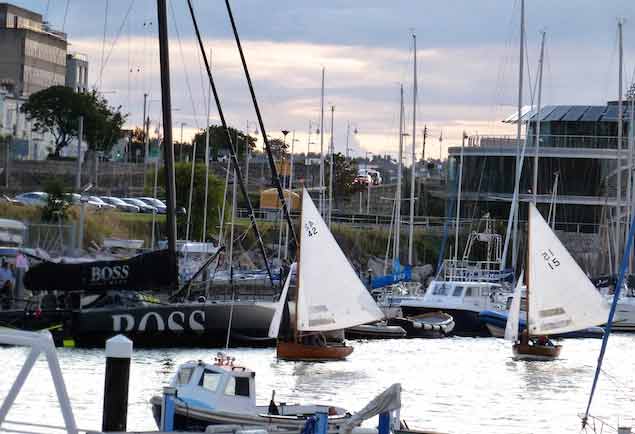 Back to base. Hugo Boss waiting to welcome William Prentice & Moiselle Hogan’s Tortoise (42, built 2006, placed 4th) and winner Mousmie (built 1910) as they return to the Royal Irish YC. Photo: W M Nixon
Back to base. Hugo Boss waiting to welcome William Prentice & Moiselle Hogan’s Tortoise (42, built 2006, placed 4th) and winner Mousmie (built 1910) as they return to the Royal Irish YC. Photo: W M Nixon
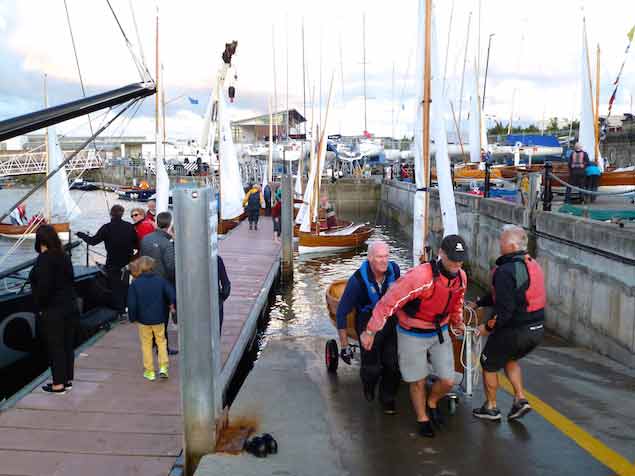 Help is always welcome when hauling a Water Wag on the slip, even at high water. Photo: W M Nixon
Help is always welcome when hauling a Water Wag on the slip, even at high water. Photo: W M Nixon
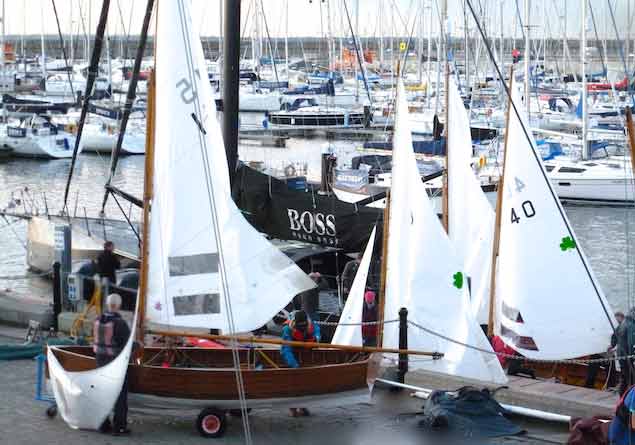 The perfect evening. The winner Moosmie (foreground) is un-rigged after being the first to win from 30 other boats, and Hugo Boss is there to see it all happen. Photo: W M Nixon
The perfect evening. The winner Moosmie (foreground) is un-rigged after being the first to win from 30 other boats, and Hugo Boss is there to see it all happen. Photo: W M Nixon
It’s a good idea to do well in the racing, as it lessens your queuing time to get up the club slips. The atmosphere around the Water Wags is so basically light-hearted – even when they’re hauling these quite heavy little boats back up the slip – that it took a while to adjust to the next mood-stage of the evening, the underlying utter seriousness involved in racing an IMOCA 60 like Hugo Boss, and particularly in such totally extreme sport as the Vendee Globe Race. Alex Thomson does a wonderful line in light-hearted patter, but what he does is mind-blowingly all-involving, and as he talked us through the financial, physical and most importantly psychological requirements for anyone even beginning to contemplate such a thing, you were left in bewilderment in grasping the scale of it all.
As to the matter of how and why he moves about the boat without being apparently concerned about being directly attached to her, he created a certain silence by saying that as you’re often sailing at 25 knots, going overboard on the end of a wire or something similar would bring the certainty of getting dragged to a particularly nasty drowning death.
Only a hundred or so people have managed to sail round the world non-stop, so there’s a real sense of community among those who have done it, and they in turn respect those who have made a whole-hearted attempt to do the same. A real high-point came when Enda O Coineen burst out of the audience and went forward to present his old mate Alex Thomson with a replacement cap for one which had been exchanged a long time ago.
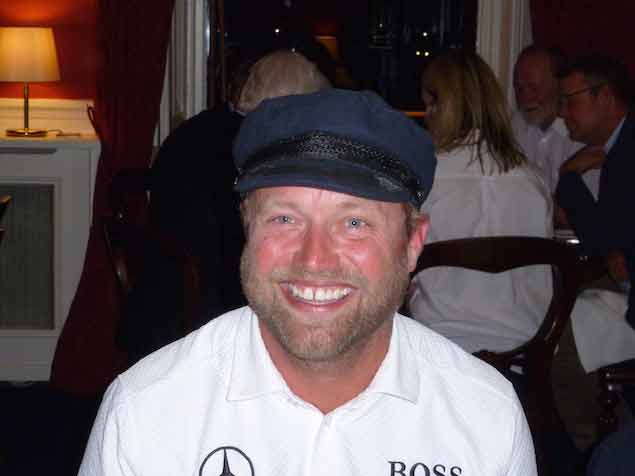 Alex Thomson with his new cap from Enda O Coineen. Photo: W M Nixon
Alex Thomson with his new cap from Enda O Coineen. Photo: W M Nixon
Stewart Hosford didn’t quite bewilder us with science, but he has such mental energy that there are times you think he’s operating on a different planet, while as for Nin O’Leary, he talked of their hopes and how he is finding it all coming together - or not. He faces a monumental challenge.
Certainly fund-raising is something that all these sailing superstars seem to gravitate towards pretty quickly, and it was in the Water Wags/Hugo Boss dinner afterwards that we could ask real questions, for the gathering in the basement room had been a pubic presentation and emphatically not a press conference. Come to that, nor was the dinner either, but things gets said across a table, and an early revelation from a notable Man Who Knows in the RIYC was that the next America’s Cup will be in skinny 73ft monohulls with enormous canting keels, which would seem to indicate that the Alinghi man who was the real backer of Team NZ is carrying the day.
Then, in his Water Wag Class Captain’s speech, Hal Sisk was in fine form, handing out the prizes with style, and taking the opportunity to present Alex Thompson with his fascinating book which convincingly argues that Dublin Bay was the cradle of modern yacht racing. Knowing that Baghdad was the cradle of civilisation, I’m not too sure that being the cradle of anything is necessarily a good thing for future prospects, but doubtless the book will have a special place in Hugo Boss’s on-board library.
As a very pleasant evening wore on, the talk became more relaxed, and in chatting about the lack of Fastnet Race success, Nin O’Leary confirmed that the construction of Hugo Boss is so specialised that any modification to fit ordinary dagger boards instead of foils would be prohibitively expense, and of limited use in hitting the overall target of a boat designed specifically for Vendee conditions, which are 90% offwind.
Thus in that frustrating upwind slog from Land’s End to the Fastnet, when holding on port tack was soon the only choice because of the huge Traffic Separation Zone, they were making ten degrees of leeway. And once they finally got to the Fastnet, there just weren’t enough miles left in getting to Plymouth to take more than one place in the IMOCA 60 class.
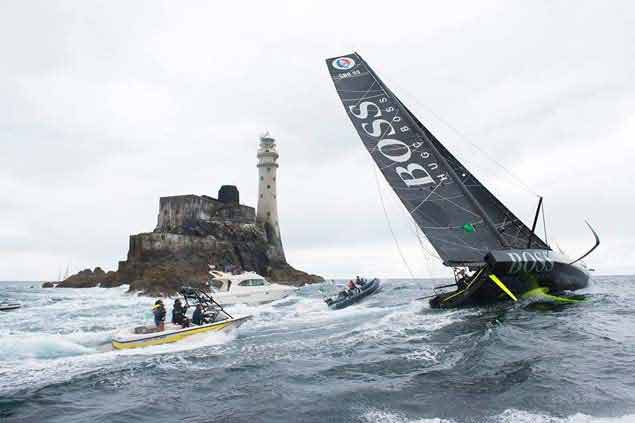 Hugo Boss with the fan club as she arrives at the Fastnet. The extreme offwind foil configuration means she makes about ten degrees of leeway when hard on the wind
Hugo Boss with the fan club as she arrives at the Fastnet. The extreme offwind foil configuration means she makes about ten degrees of leeway when hard on the wind
The problem is that with such a purpose-designed boat, the number of useful events is limited. In the interim, between races which suit, they have to make do with what’s available, so their next outing will be the Middle Sea Race on 28th October. The winds in that are notoriously all over the place, but who knows, they might get lucky, and it’s all experience even though they’re allowed to carry extra hands. But it won’t be more than three at most, as more bodies just get in the way in a cockpit optimised for one.
For Alex Thomson, the Hugo Boss sponsorship, with major support from Mercedes, is in place for 2020, but his team are willing to take in any extra interest, as the boat we were being amazed by at the Royal Irish cost a basic of €5 million, and a new one won’t be any cheaper. As for Nin O’Leary, he seems to be aiming for a boat he can initially secure for €3.6 million, but will need continuing investment thereafter.
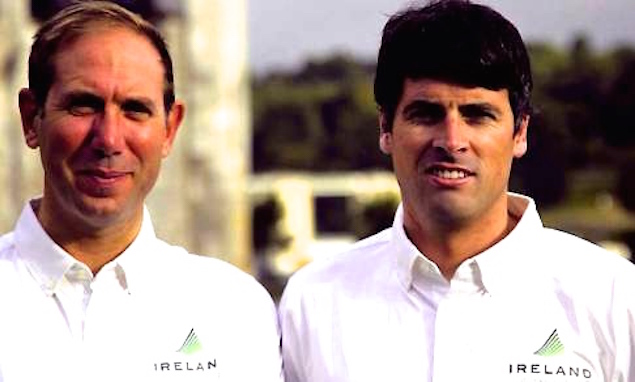 Stewart Hosford and Nin O’Leary
Stewart Hosford and Nin O’Leary
You cannot but be intrigued by the Hugo Boss setup. The boat looks and is the quintessential expression of modern German industry and commerce. Yet she’s sailed by a jolly Englishman whose main performance theatre is provided by France. And the technical management behind it all is provided by a peripatetic Corkman.
Into this whirling maelstrom of possbilities and challenges has stepped a 31-year-old Irish sailing star who is learning just as fast as he can by sailing as co-skipper on Hugo Boss, yet the logic is that he in time will have to think of his own boat. In fact, everybody is taking a very mature approach to this. The only relative certainty is that they’ll be doing the Middle Sea Race together in eight weeks time. Beyond that, the ideal might be the two-handed Barcelona World Race in May 2018, but if Nin O’Leary has his own boat by that time, then he’ll be going with that, and Alex Thomson will have to find another co-sailor.
It’s a world of long-term goals in which you have to be prepared for changing situations from minute to minute, or even second to second. We’re astonished by the sheer challenge of the big events, without thinking of the shoreside work. The bigger the sponsorship, the more demanding the sponsor will expect to be of the star’s time.
Set against the innocent amateur sport of Water Wag racing, the contrast was total. You really couldn’t have asked for a better way of grasping the enormity of what these guys take on.
Over a number of years, the numbers of Water Wag competing in club racing, on Wednesday evenings, has been bucking the national trend, by increasing in numbers of competitors. Hal Sisk, the 2017 Captain of the Water Wags, decided that the race for the Captain’s Prize, would be an opportunity to break the current world record for Water Wags in the same race, which currently stands at twenty-eight.
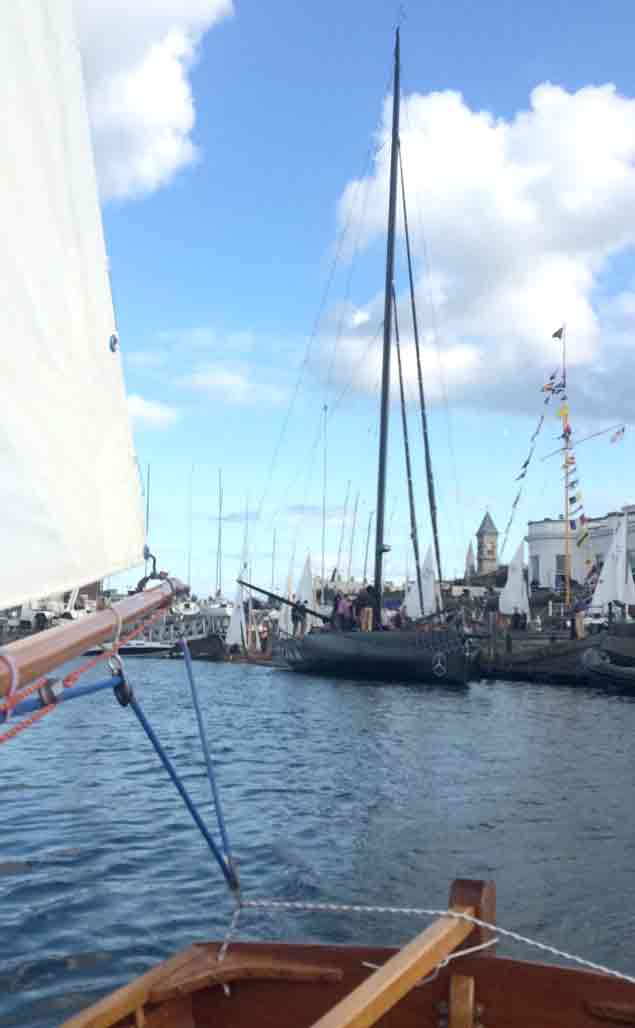 The Royal Irish Yacht Club was abuzz with the arrival of Hugo Boss boat and the Water Wags Captain’s Prize. Photo: Amy O'Leary
The Royal Irish Yacht Club was abuzz with the arrival of Hugo Boss boat and the Water Wags Captain’s Prize. Photo: Amy O'Leary
On 30th August, the light wind was somewhat unstable, and blowing from the west. The committee, under the leadership of Tom Hudson laid a windward mark off the marina entrance, and a clever start line, long enough for thirty Water Wags, with a pin end advantage, which could have led the competitors into the lighter wind close to the shore, while those starting near the committee boat could tack away, into the last of the flood tide at the harbour mouth to their advantage. With a large fleet, one might have expected a general recall, but only two boats were recalled. At the first windward mark, the leader was Pansy, (at 111 years old, the second oldest boat competing) who had started near the pin mark, followed by Moosmie and Eva. The race was four windward-leeward laps of the harbour. At the bottom of the run, the gate marks were widely spaced. Pansy opted for the north mark, while Moosmie and Eva took the south mark, which dropped Pansy to third place at the second windward mark. It appeared that the best course was to sail up the middle of the harbour.
At the next windward mark, Swift moved up into third place. On the next run, there was a big wind shift. The boats which gybed quickly did best out of this change, which turned the north gate mark into the preferred one. At the third windward mark Tortoise was in third place. The wind was growing in strength, which brought six boats to the finish line together. They crossed the line in the following order.
1st –15, Moosmie. David MacFarlane.
2nd.– 8, Barbara, Ian & Judith Malcolm.
3rd. 33, Eva, Katie Tingle & Dermot O Flynn (Winner division 1B)
4th.. -42, Tortoise, William Prentice & Moiselle Hogan.
5th. - 38, Swift,
6th, -24, Gavotte.
7th. -46, Mademoiselle.
8th. -3, Pansy.
9th.-32, Skee.
10th. -9, Marie Louise.
11th. – 17, Coquette.
12th. – 44, Scallywag.
13th.- 18, Good Hope.
14th. 26, Nandor (Winner division 2)
15th. -6, Mary Kate.
16th. -47, Peggy.
17th. – 43, Freddie.
18th. -30, Sara.
19th. – 14, Phyllis.
20th. - 36, Little Tern.
21st. – 40, Swallow.
22nd. – 16, Penelope.
23rd. – 12, Alfa.
24th. – 20, Badger.
25th. - 4, Vela.
26th. – 31, Polly.
27th – O8, Eros.
28th. –34, Chloe.
29th – 10, Sprite.
OCS- 41, Mollie.
OCS- 45, Mariposa.
The world record attendance of 31 Water Wags was achieved, and celebrated afterwards with a dinner in the Royal Irish Yacht Club.
There is a Sport of Sailing & a Sport of Yacht Ownership
“For many people yacht ownership is enough. They buy a boat and they keep it in a marina and they don’t go sailing very often and they go there for picnics and so on, but for some people you can combine the two and you can get the best enjoyment from your boat, using it, which is the main thing.”
There is a sport of sailing and there is a sport of yacht ownership, glassfibre boats are a bit anodyne and Dublin has the classiest of boats sailing. Those are pretty strong views, but made by a man whose opinions command respect - the exponent of classic boats, yacht restoration and history, Hal Sisk, who I met as he was attending to his Water Wag, Good Hope, which he has been racing for 39 years and that he had brought to the West Cork harbour of Glandore for the Classic Boats Regatta. We discussed what is happening to yacht racing and concern that fleets have been falling off in numbers around the coast. “In 1887 Water Wags gave the world the first one-design boat and we still race them every week in Dublin Bay. When I started in the Class we had five or six racing. We had 27 last week on the water and more young people are joining the Class in which there is a great buzz. That shows what can be done in racing.”
We discussed glass fibre yachts which he considers a bit “anodyne” and doesn’t find them as interesting as the wooden classics. He pointed to the “National 18 wooden clinker boats, a fine boat,” but mostly gone from the racing scene. He contrasted this with older wooden boats still actively racing in Dublin, pointing to the Water Wages, the Howth 17s and the Glen 21s.
Hal Sisk has boundless enthusiasm for the sport which comes across in my interview with him which you can hear on this week’s Podcast. Also on the PODCAST, this Saturday is Whale Watch Day. The Irish Whale and Dolphin Group has recorded a thousand sightings of whales and dolphins this Summer, but there are fears that ‘killer whales’ could be threatened with extinction in Europe. Whale Watching locations and details are here:
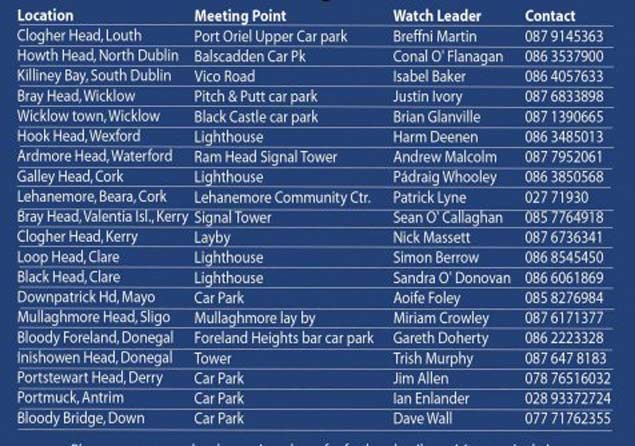
LISTEN to the PODCAST:
Tom MacSweeney presents THIS ISLAND NATION programme on radio stations around Ireland


























